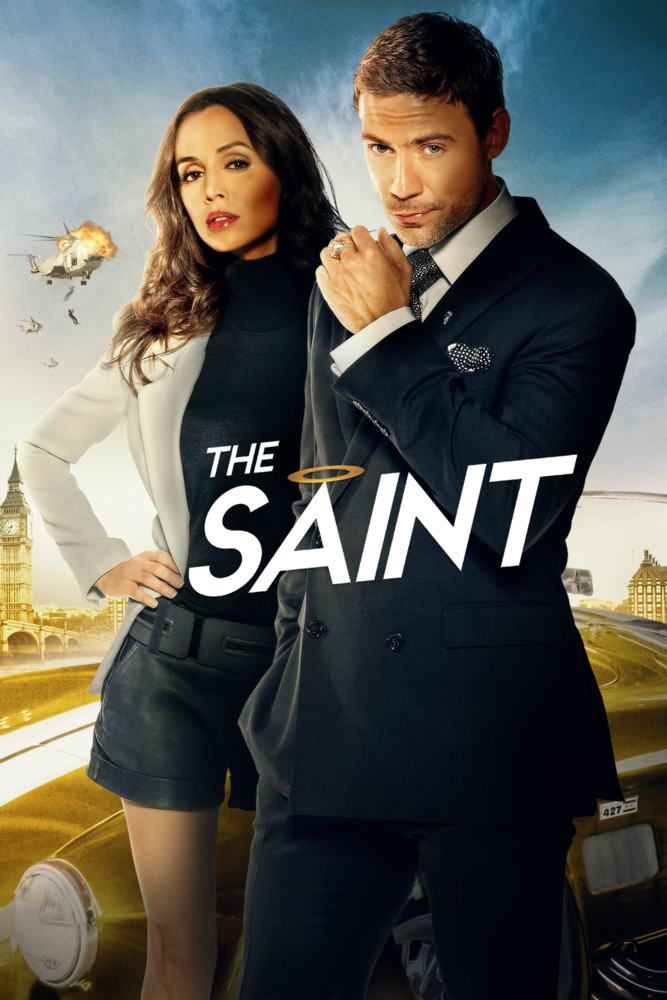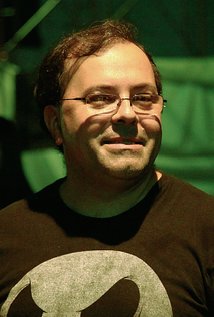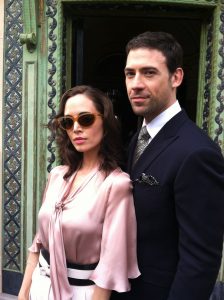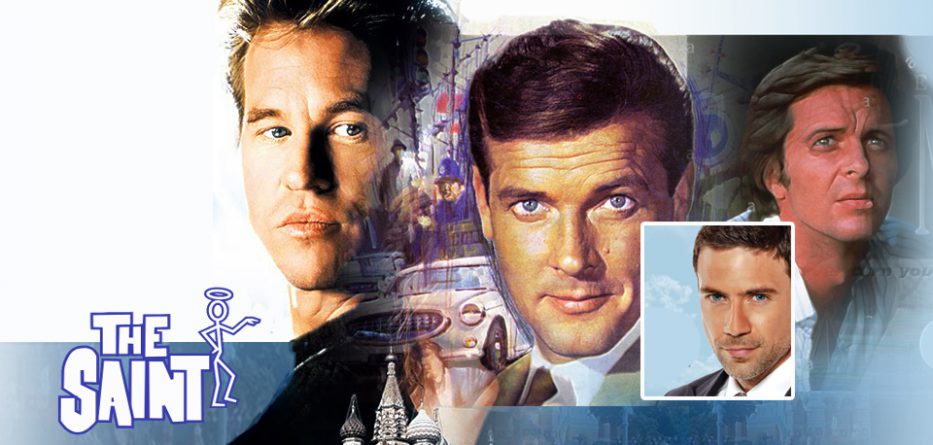I grew up watching the adventures of Simon Templar aka The Saint on TV, both reruns of Roger Moore’s classic interpretation that ran from 1962-1969 and the latter incarnation Return of the Saint which saw Ian Ogilvy bringing the character back to the screen. Originally reated by Leslie Charteris in the 1920’s, Simon Templar is a Robin Hood styled criminal who rights wrongs even if he finds himself at odds with the law, and leaves a calling card, a stick figure of a man with a halo. Since those incarnations of the character, there have been a number of attempts to return the character to the spotlight – the most high profile being the Val Kilmer take on the character in 1997 for a movie that expands upon certain elements of the character’s origins but failed to deliver the action and adventure needed for the character.
The most recent attempt to adapt the material and concept was the announcement of a new incarnation of The Saint with Adam Rayner as Simon Templar/The Saint and cult heroine Eliza Dushku (Buffy, Dollhouse, banshee, Bull) as Patricia Holm. However, while a glossy trailer surfaced a few years back, the project vanished into the shadows. But now thanks to director Ernie Barbarash (Six Bullets, Pound of Flesh, Falcon Rising) we will finally get to see that version of The Saint…
EchoChamber: Some basic questions to begin with…Who is The Saint? Who is Simon Templar? Were you aware of the character and the franchise before you got involved?
Ernie Barbarash: The Saint is a modern day Robin Hood, but also equal parts James Bond, Bruce Wayne and Zorro thrown in. He’s a hero we could really use here in United States right now. Someone who steals from the corrupt rich and returns the money to the poor… Simon Templar would surely be a busy guy over here… To answer your other question, yes, I was aware of the character and the franchise but certainly not to the degree I wish I had been. I do remember reading one of the first Saint books, Enter The Saint when I was in my early teens maybe – I remember it was the same summer as I read literally all of Ian Fleming’s James Bond books – and once I was done with them, the librarian recommended The Saint but it was right at the end of the summer so school started up again…
 EC: The reboot of The Saint was originally shot as a pilot for a proposed new tv series with Simon West at the helm (with Adam Rayner as Simon Templar/The Saint, Eliza Dushku as Patricia Helm and cameos by Roger Moore and Ian Ogilvy, both earlier tv incarnations of the character). Can you tell us/any idea why that didn’t go to full series and how you get involved?
EC: The reboot of The Saint was originally shot as a pilot for a proposed new tv series with Simon West at the helm (with Adam Rayner as Simon Templar/The Saint, Eliza Dushku as Patricia Helm and cameos by Roger Moore and Ian Ogilvy, both earlier tv incarnations of the character). Can you tell us/any idea why that didn’t go to full series and how you get involved?
EB: I have no idea why the series never went forward. As the saying goes, that’s above my pay grade. I got involved in the project when Brad Krevoy, who’d produced the pilot – and with whom I’ve collaborated on multiple films over the years – called me and asked if I’d take a look at this pilot for The Saint they had finished almost four years before…and see if I could figure out how to turn it into a full length movie. The catch was that to get Adam Rayner and Eliza Dushku back to shoot, we had a very short window of time with them… Adam was still shooting his series Tyrant. So on one hand, it was going to be a challenging schedule for any number of reasons. On the other, the tight schedule was the reason I was asked to direct the full length movie to begin with – because Simon West, who had directed the original pilot, wasn’t available at the same time that the actors were.
As far as what writing/rewriting and directing the full length movie version entailed, it was quite an intricate puzzle – which is what really intrigued me about the project. I’d never done anything like this before…to incorporate a tv pilot that had already been shot by someone else…. Basically, because of our tight schedule we had to figure out how to use as much of the original pilot that was shot as possible, and flesh out the story around it to the tune of TWICE the amount of screen time – which is, let me tell you, no small feat. Thanks to our cast and crew and producers, we succeeded in shooting about 46 minutes of new material to turn a 44 minute pilot into 90 minute movie.
Now luckily for me, in the intervening years between the pilot being completed and when I was brought on board, there had been a few versions of this extended movie version of the pilot written by two excellent writers working separately: one is Tony Giglio and the other is John Turman…. who wrote a film called Ticking Clock which I directed some years back. In putting it all together, I took chunks of Tony’s structure, added some of my own, then got some great character work from John, and melded it together. There were very real challenges of Adam being on a tv show right after, so we couldn’t really alter his hair, and beard no matter how much he personally wanted to help out, and Eliza also had prior commitments so we had to shoot a lot of her new material in LA instead of Eastern Europe…
EC: It sounds like many people and working parts had to work together to make it all happen…
EB: Because everyone was so incredibly cooperative, we made it work – in no small part because of some genius planning and organisation by one of our producers, the indefatigable Amy Krell (with whom I’ve since collaborated on a number of other films), as well as everyone at Castel Studios in Bucharest, our Romanian cinematographer Viorel Sergovici, our production designer Sorin Dima, and our entire Romanian crew who were top notch as always, and of course Brad Krevoy and everyone at MPCA – Amanda Phillips Atkins, Eric Jarboe, Vince Balzano, Lorenzo Nardini – some of whom had been with the project from the start and who were incredibly supportive.
All in all, it was a really tight knit group of people working on the film and that, more than anything else, allowed us to get some very effective results in a fraction of the time and resources they’d originally had for the pilot. While I’m spreading thanks around, I certainly can’t forget our editor Mike Purl and the team at Heath Ryan’s Pace Pictures, as well as my longtime collaborator, composer Neal Acree, who did a great job composing a full new score for the film. We really felt like it was important for the music to at least be one organic whole rather than trying to use some composition from before/new… I think Neal’s music not only works well but ties everything together — and finally a real thank you and shout-out to Joe Melody and Rick Steele at Smart Post Sound here in LA who did such a phenomenal job with both sound and VFX work on the project.

Ernie Barbarash
EC: How much leeway were you given in reworking the original concept in terms of story/tone, characters and cast? Did you have any interaction with Simon West about the reshoots and your involvement?
EB: I was given a lot of leeway vis a vis storyline, characters and cast – we even added a number of new characters, recast one completely with a new actor, greatly expanded Ian Oglivy’s role, added a role to take place of the role of an actor who wasn’t available at all, and then had to work him in as seamlessly into the movie as possible. Again, it was very tricky because of our limited timeline of when we could get a number of the original actors, so a number of creative decisions really had to be made within the time-frame. We either made The Saint into a full length film under these circumstances or we weren’t going to make it at all. And sadly, because he was busy with another project and I had to just go go go to meet the deadline on this, I really didn’t have any interaction with Simon West except after we’d completed the movie – which is a shame because he’s a really talented director.
EC: With several years having passed since the original shoot, did anyone have any trepidation about resuming the shoot and trying to recapture the energy?
EB: I can’t speak for anyone else, but I was certainly worried about the time that had passed and how the cast would react to a new director, etc., but thanks to everyone’s professionalism, kindness and goodwill, everything worked very smoothly. I think what helped is that we wrote out the script for the full length movie version in a way that showed exactly how the 50 mins of new material really dovetailed with the pilot that they’d already shot, including literally writing out the scenes that we intended to use from the pilot, with some additional dialogue recording changing lines that don’t make sense in the new context, etc. This way everyone, cast, crew, editors, etc., could all see how everything would eventually fit together and to see that we were working very hard not to just redo stuff for no reason – we really wanted to be true to what was already shot.
I think this preparation of the script in a detailed way really helped give them a bit of comfort that we knew what we were doing and that we had a real plan. I remember Adam Rayner being very supportive of how we’d managed to stay true to the character of the Saint and especially to the humor of Simon Templar that had been set up in the original pilot and the archetype of The Saint back to the books even. Again, we really couldn’t have gotten anywhere without the cast’s goodwill, support and trust. I remember saying to Adam and Eliza and Ian in the little prep we had together that since they’d already shot the pilot, I very much counted on them to keep me honest on keeping their characters consistent and authentic to what they’d already done. And they did.
I’m a firm believer that if you’re up-front with actors, or really any other coworkers and show them that you’re working at least as hard as everybody else on the team that they will rise to the challenge. Andrei Serban, a brilliant theatre director and teacher of mine once posed a very important question to us, something that always stays with me: ‘When someone looks at a blueprint, do they care about the line that’s been drawn or the personality of whoever drew the line?‘ – and of course the answer is that no one gives a damn about the personality of whoever drew it – it’s a reminder that the work is always first and I find that people really respond to that.
EC: Did you have much chance to bring your own style and ideas or were you given a strict set of guidelines to follow?
EB: I wasn’t given a strict set of rules at all… but I did feel it incumbent upon me and the rest of our team to be faithful to the look and feel and tone of the original pilot – because they really had done a great job of capturing the right tone of The Saint’s world or what it would be like today and of Simon Templar’s character. Also, this wasn’t like having a new director shoot another director’s script – we literally were using as much of the pilot that was already shot as possible, so that the look really had to match too… Where I brought my ideas, as well as the other writers, Tony and John, was in the way we fleshed out the story, the way we created new scenes for Simon Templar that were true to his character and voice, and what I thought were plausible hints at an origin story – as well as some new scenes for some of his opponents. This wasn’t just a matter of creating backstory and flashbacks, but also filling in the gaps that were left in the pilot because I’m sure they intended to fill them in in future episodes.
EC: Did you get to interact with the original Saints? Having worked with Val Kilmer on Hardwired, did you ever think about reaching out to him to have him cameo in some way shape or form?
EB: Luckily, I did get to work with both of our “original Saints” – but sadly not in exactly the same way. I got to expand Ian Oglivy’s role a lot, which was a lot of fun to write and even more fun to bring to life with him on set. We had a blast shooting in, of all places, one of Romanian dictator Nicolae Ceaușescu’s lavish offices – and I remember us joking that it was an appropriate place for his character… On the shoot we also realised that even though we’d never worked together before, that I knew and had frequently worked in LA with his two stepsons, Sam and Lee Boxleitner, who are not only great guys, but really cool young horror filmmakers.
Unfortunately I only got to work with Roger Moore via Skype when we needed him to do some additional/changed dialogue in ADR. He was really a very sweet, generous and incredibly talented man, who gave it his all and delivered more than we’d hoped for even though he might not have been in the best of health at the time – but I was so grateful to even have this chance. What a class act! He was really surprised – I think delightfully so – at how we’d shifted his role a bit and really gave it a solid purpose and a surprise twist of sorts for the story, compared to what he’d done in the pilot. He really seemed to enjoy working it through with us for even that brief period of time.
In terms of Val Kilmer, to be honest, there was really no way I could fit yet one more cameo or additional role in there. Given what we were trying to do in a really tight window of time, there just wasn’t room or time to jam one more character in there who hadn’t been in the original pilot – we were already juggling so many elements that had to fit right into what had already been shot.
 EC: How would you describe your/you & Simon West’s take on The Saint to the potential audience?
EC: How would you describe your/you & Simon West’s take on The Saint to the potential audience?
EB: I really don’t want to speak for Simon, but what I think I added was the idea of turning it into more of an origin story and really introducing and showing rather than talking about Simon Templar as a rogue who steals from the criminally wealthy and physically returns it to the poor… And given our production parameters and the time that had passed since the pilot had been shot we had to be really careful about what we shot that had to happen “in the present day” of the story … to directly match what had been shot before. Also, just to be clear, the idea of having stories of Simon’s family flashbacks wasn’t mine – there had been flashbacks shot for the pilot – but our expanded story really required for us to shoot longer, more involved flashbacks that told a completely different story, so we shot all new material for that and didn’t use any of the flashbacks that had been shot before.
As for my ‘take’ on The Saint, I’d like to let the audience see the movie and respond for themselves what they got out of it. I hope we didn’t stray too far with our version of The Saint mythology and I hope people enjoy the movie.
BC: If the opportunity came to return to the world of Simon Templar would you take it?
EB: I would absolutely take it. I feel like I just dipped my feet into the pool and I’d love a shot at taking a real swim. This was a very specific project with very specific parameters. I’d love to explore The Saint a lot more, and given the opportunity, a dare I say a slightly darker incarnation might be in order… But still without losing the humor. I bet if I got together with Ian Dickerson, we could cook up something really interesting. Ian was our co-producer and a creative consultant on the project from even back when it was a pilot for a series, and was a huge help. He is one of the most if not the most knowledgeable guy about The Saint out there, period
EC: What’s next for Ernie B?
EB: Right now I’m in post-production for a Netflix original romantic comedy called Christmas Inheritance, with Eliza Taylor from The 100, Jake Lacy from Girls and Andie MacDowell – one of the best casts with whom I’ve ever had the pleasure of working. After that I’ll be directing, and not necessarily in this order, a really original martial arts/science-fiction film to be shot in China and probably Vietnam. I’m really excited about that one because we’re in the process of working out the script just now and it’s going really well as a really surprising, character driven action movie with some serious sci-fi surprises – and even though the cast isn’t quite confirmed yet, I can quietly confirm that we’re speaking to some amazing martial artists… Either right before – or right after – that dose of martial arts and sci-fi magic, I’ll be directing a really cool realistic disaster movie called Flare, which I’m collaborating on with its creators, Patti Beninati and Michael Anderson from Centerboro Films, as well as Todd Slater and Jonathan Black of Blue Fox Entertainment – and I’ve already scouted a pretty incredible location in Mojave where parts of the movie will be shot. So yeah – definitely keeping busy.








